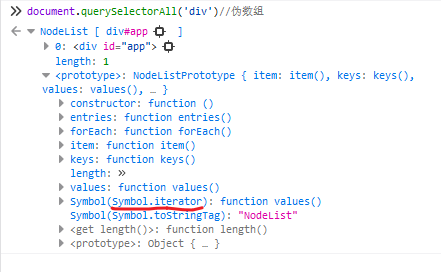生成器和迭代器
生成器
跟ES6中的生成器是一样的
typescript
//1. 生成器 用法一样
function* gen(){
yield Promise.resolve('rarrot')//同步异步
yield '666'
yield '123'
yield '000'
}
const man=gen()
console.log(man.next())//{ value: Promise { 'rarrot' }, done: false }
console.log(man.next())//{ value: '666', done: false }
console.log(man.next())//{ value: '123', done: false }
console.log(man.next())//{ value: '000', done: false }
console.log(man.next())//{ value: undefined, done: true }迭代器
迭代器是一个可以由任意对象实现的接口,支持连续获取对象产出的每一个值。任何实现 Iterable 接口的对象都有一个 Symbol.iterator 属性,这个属性引用默认迭代器。默认迭代器就像一个迭代器工厂,也就是一个函数,调用之后会产生一个实现 Iterator 接口的对象,使用这个对象可以调用next()方法。
typescript
// 2. 迭代器
// 3. 用set map做例子
let set: Set<number> = new Set([1, 1, 2, 2, 3, 3])//自动去重
// Set(3) { 1, 2, 3 }
console.log(set)
let map: Map<any, any> = new Map()
let Arr = [1, 2, 3]
map.set(Arr, 'rarrot')
map.set('1', '你是谁')
console.log(map.get(Arr))//把Arr数组当key,'rarrot'为value,所有输出rarrot
function args() {
console.log(arguments)//伪数组
}
// let list =document.querySelectorAll('div')//伪数组,如下图
// 自定义for of
const each = (value: any) => {
let It: any = value[Symbol.iterator]()
let next: any = { done: false }
while (!next.done) {
next = It.next()
console.log("🚀 ~ file: index.ts:39 ~ each ~ next:", next)
if (!next.done) {
console.log(next.value)
}
}
}
/*
` 🚀 ~ file: index.ts:39 ~ each ~ next: { value: 1, done: false }
` 1
` 🚀 ~ file: index.ts:39 ~ each ~ next: { value: 2, done: false }
` 2
` 🚀 ~ file: index.ts:39 ~ each ~ next: { value: 3, done: false }
` 3
` 🚀 ~ file: index.ts:39 ~ each ~ next: { value: undefined, done: true }
*/
each(set)
/*
` 🚀 ~ file: index.ts:39 ~ each ~ next: { value: [ [ 1, 2, 3 ], 'rarrot' ], done: false }
` [ [ 1, 2, 3 ], 'rarrot' ]
` 🚀 ~ file: index.ts:39 ~ each ~ next: { value: [ '1', '你是谁' ], done: false }
` [ '1', '你是谁' ]
` 🚀 ~ file: index.ts:39 ~ each ~ next: { value: undefined, done: true }
*/
each(map)
迭代器的语法糖(for of)
typescript
// 对象不能用for of
for(let value of map){
// [ [ 1, 2, 3 ], 'rarrot' ]
// [ '1', '你是谁' ]
console.log(value)
}解构
底层原理也是去调用iterator
typescript
let [a,b,c]=[4,5,6]
console.log(a,b,c)//4 5 6
let a1=[4,5,6]
let copy=[...a1]
console.log(...a1) // 4,5,6
console.log(copy) // [ 4, 5, 6 ]对象中实现迭代器
其实很简单,就是current的增加,直到current=true才停止,返回value为underfined和done为true。未停止就返回current的值,以及done为false。
typescript
let obj = {
max: 3,
current: 0,
[Symbol.iterator]() {
return {
max: this.max,
current: this.current,
next() {
if (this.current == this.max) {
return {
value: undefined,
done: true
}
} else {
return {
value: this.current++,
done: false
}
}
}
}
}
}
for (let value of obj) {
// 0
// 1
// 2
console.log(value)
}
// 遍历这个对象并将 next() 的返回值收集到数组中
let x = [...obj]
// [ 0, 1, 2 ]
console.log(x)
// 对象解构,执行对象自己的可枚举属性的浅拷贝,它实际上不遍历obj对象。
let o = { ...obj }
/*
{
max: 3,
current: 0,
[Symbol(Symbol.iterator)]: [Function: [Symbol.iterator]]
}
*/
console.log(o)